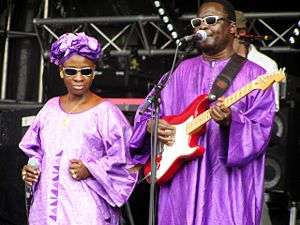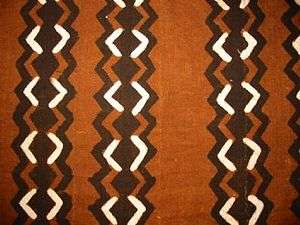Culture of Mali

The culture of Mali derives from the shared experience, as a colonial and post-colonial polity, and the interaction of the numerous cultures which make up the Malian people. What is today the nation of Mali was united first in the medieval period as the Mali Empire. While the current state does not include areas in the southwest, and is expanded far to the east and northeast, the dominant roles of the Mandé peoples is shared by the modern Mali, and the empire from which it took its name.
In the east, Songhay, Bozo, and Dogon people predominate, while the Fula people, formerly nomadic, have settled in patches across the nation. Tuareg and Maure peoples continue a largely nomadic desert culture, across the north of the nation. The interaction of these communities (along with dozens of other smaller ethnicities) have created a Malian culture, marked by heterogeneity, as well as syntheses where these traditions intermix.
Ethnic patchwork and intermixing
Mande peoples share a caste system in which certain skills (metalworking, fishing, history-keeping) are passed down through families. The rituals and cultural associations of these activities have spread far beyond the Mande communities themselves.
While the Malinké, Soninke - Sarakole, Dyula, and Bambara peoples form a Mande core (at around 50%) of Malian culture in the densely populated regions of the south and east, a mosaic of other cultures also contribute to Malian society.
The Fula people, originally nomadic but now as often village and city dwelling, are scattered in communities across the nation as they are over much of West Africa. Fula peoples were amongst the first and most fervent believers in Islam, which orders the lives of the vast majority of Malians. The Fula traditions of nomadic cattle herding has bequeathed values of mobility and independence, and at the same time created networks of mutual dependence between certain communities and cultures. The Fula transhumance cycle meant that entire Fula tribes would spend seasons living in Bambara communities, creating formalized relationships called Cousinage.[1] This survives to this day as the Malian cultural institution known as sanankuya, or the "joking relationship". In Mali, the state of Macina, in the midst of the Inner Niger Delta was dominated by Fula people and culture.[2]
Dogon and Songhay peoples are dominant in the east of the country, with the Songhay Empire pushing traditionally animist Dogon deep into the isolating hill country of the southeast. Here the Dogon have maintained a unique culture, art, and lifestyle which has become a source of pride for all Malians.
All along the edge of the Sahara, and far into the dry land of isolated oases live the nomadic Berber Tuareg and the (in the northwest) Maures (or Moors), of Arab-o-Berber origins. While making up only 10% of the population, these groups bring a distinct culture to modern Mali.
Music

Malian musical traditions are often derived from Mande griots or jalis, a family-based caste of performing poets. While today, griots are often seen as praise singers at local weddings or civic events, where historically they served as court historians, advisors, and diplomats.
The music of Mali is best known outside of Africa for the kora virtuosos Toumani Diabaté and Ballaké Sissoko, the late roots and blues guitarist Ali Farka Touré, and his successors Afel Bocoum and Vieux Farka Touré, the Tuareg band Tinariwen, and several Afro-pop artists such as Salif Keita, the duo Amadou et Mariam, and Oumou Sangare.
Literature
Though Mali's literature is less famous than its music,[3] Mali has always been one of Africa's liveliest intellectual centers.[4] Mali's literary tradition is largely oral, with jalis reciting or singing histories and stories from memory.[4][5] Amadou Hampâté Bâ, Mali's best-known historian, spent much of his life recording the oral traditions of his own Fula teachers, as well as those of Bambara and other Mande neighbors.[5]
The best-known novel by a Malian writer is Yambo Ouologuem's Le devoir de violence, which won the 1968 Prix Renaudot but whose legacy was marred by accusations of plagiarism. It is a dark history of a loosely disguised Bambara Empire, focused on slavery, injustice and suffering.[4][5]
Massa Makan Diabaté, a descendant of griots, is known in the Francophone world for his work on The Epic of Sundiata as well as his "Kouta trilogy," a series of realist novels loosely based on contemporary life in his hometown of Kita. Other well-known Malian writers include Baba Traoré, Modibo Sounkalo Keita, Maryse Condé (a native of the French Antilles, has made a career writing about the Bamabara people from whom she descends), Moussa Konaté, and Fily Dabo Sissoko.[4][5] Ousmane Sembène, a Wolof Senegalese novelist, set half of his novel God's Bits of Wood in Bamako.
Festivals, food, and clothing

The varied everyday culture of Malians reflects the country's ethnic and geographic diversity.[6] Most Malians wear flowing, colorful robes called boubous, that are typical of West Africa. Malians frequently participate in traditional festivals, dances, and ceremonies.[6]
Public holidays
Friday and Sunday are half days at most businesses, while Saturday is usually a day of rest. Friday afternoon is the time of Muslim weekly prayers, while the half day on the Christian sabbath is a tradition from the time of French colonial rule.[7] Muslim, Christian, and National celebrations are marked as public holidays in Mali.
Food
Rice and millet are the staples of Malian cuisine, which is heavily based on cereal grains.[8][9] Grains are generally prepared with sauces made from a variety of edible leaves, such as spinach or baobab, with tomato peanut sauce, and may be accompanied by pieces of grilled meat (typically chicken, mutton, beef, pork, or goat).[8][9] Loco "plantains" are eaten most of the time along with tea
Malian cuisine varies regionally.[8][9] Other popular dishes include fufu, jollof rice, and maafe.
Textiles

Bògòlanfini ("mud cloth"), a handmade cotton fabric, traditionally dyed with fermented mud, has an important place in traditional Malian culture, and has more recently, become a symbol of Malian cultural identity. The cloth is being exported worldwide for use in fashion, fine art, and decoration.
Sports

Football is the most popular sport in Mali.[10][11] Mali's national team became more prominent, after hosting the 2002 African Cup of Nations.[10][12] Most towns and cities have regular games;[12] the most popular national teams are Djoliba, Stad, and Real.[11] Informal games are often played by youths, using a bundle of rags as a ball.[11]
Mali has produced several notable players for the French team, including Salif Keita and Jean Tigana.[10][11] Basketball is another major sport;[11][13] the Mali women's national basketball team is the only African basketball team that competed at the 2008 Beijing Olympics.[14] Traditional wrestling (la lutte) is also somewhat common, though its popularity has declined in recent years.[12] The game wari, a mancala variant, is a common pastime.[11]
References
- ↑ Cécile Canut et Étienne Smith, Pactes, alliances et plaisanteries. Pratiques locales, discours global, Cahiers d'études africaines, Parentés, plaisanteries et politique, No 184 (2006)
- ↑ Claude Fay,"Car nous ne faisons qu’un", Identités, équivalences, homologies au Maasina (Mali), Cahiers des Sciences Humaines, Vol. 31, 1995, p. 427-456
- ↑ Velton, p29.
- 1 2 3 4 Milet & Manaud, p128.
- 1 2 3 4 Velton, p28.
- 1 2 Pye-Smith & Drisdelle, p13.
- ↑ Ly, Anh. Dispatch from Mali: Democracy at Play -- Soccer Coverage and Viewing for All. Framework: The Journal of Cinema and Media - Volume 48, Number 1, Spring 2007, pp. 97-102
- 1 2 3 Velton, p30.
- 1 2 3 Milet & Manaud, p146.
- 1 2 3 Milet & Manaud, p151.
- 1 2 3 4 5 6 DiPiazza, p55.
- 1 2 3 Hudgens, Trillo, and Calonnec, p320.
- ↑ "Malian Men Basketball" Archived January 1, 2008, at the Wayback Machine.. Africabasket.com.
- ↑ Chitunda, Julio. "Ruiz looks to strengthen Mali roster ahead of Beijing". FIBA.com (March 13, 2008).
Works cited
- DiPiazza, Francesca Davis. Mali in Pictures. Twenty-First Century Books (2007). ISBN 0-8225-6591-9.
- Hudgens, Jim, Richard Trillo, and Nathalie Calonnec. The Rough Guide to West Africa. Rough Guides (2003). ISBN 1-84353-118-6.
- (French) Milet, Eric & Jean-Luc Manaud. Mali. Editions Olizane (2007). ISBN 2-88086-351-1.
- Pye-Smith, Charlie & Rhéal Drisdelle. Mali: A Prospect of Peace? Oxfam (1997). ISBN 0-85598-334-5.
- Velton, Ross. Mali. Bradt Travel Guides (2004). ISBN 1-84162-077-7.